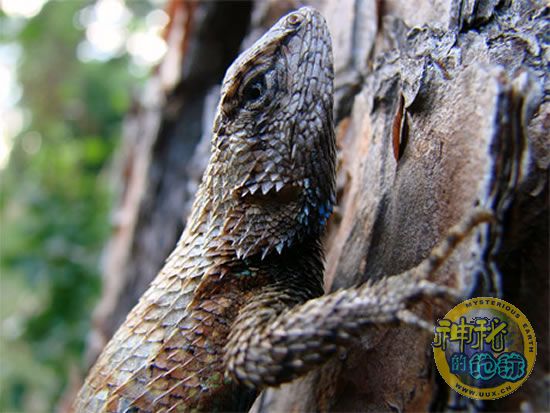Lizards Evolving Rapidly to Survive Deadly Fire Ants
Long legs and skittish behavior are recently evolved traits that allow native fence lizards (pictured above, a lizard in Alabama) in the southeastern U.S. to co-exist with lethal and invasive fire ants, a January 2009 study said.
The new findings could boost hopes for species facing quickly changing habitats due to climate change, experts say.
Photograph courtesy Tracy Langkilde/Pennsylvania State University
John Roach
for National Geographic News
January 21, 2009
Long legs and skittish behavior are recently evolved traits that allow fence lizards in the southeastern U.S. to co-exist with lethal and invasive fire ants, according to a new study.
The new findings could boost hopes for species whose habitats are quickly changing due to climate change, experts say.
The venom-packed stings of just 12 fire ants can kill a three-inch-long (eight-centimeter-long) fence lizard in a minute, according to lead study author Tracy Langkilde, a biologist at Pennsylvania State University. The ants have been known to strip animals as large as calves down to the bone.
But some lizards twitch vigorously and flee the scene whenever ants attack, a defensive behavior that sheds the insects before they can pry up the reptiles' scales and sting the soft flesh underneath.
The findings, Langkilde said, are evidence of a rapid evolutionary response to the fire ants.
Survival of the Fittest
Fire ants were accidentally introduced to the U.S. from South America in the 1930s, possibly via shipping ports in Alabama.
Without a method for controlling the population, scientists believe fire ants—which have no natural predators, in the U.S.—will eventually colonize more than 50 percent of Earth's land surface.
Longer hind limbs appear to help the lizards twitch and flee more effectively, said Langkilde, who received funding for her study from the National Geographic Society's Committee for Research and Exploration. (The National Geographic Society owns National Geographic News.)
Langkilde studied adult lizards from four populations and found that extended limbs and skittish tendencies were increasingly more common at sites where lizards and fire ants had co-existed longer.
At a fire-ant-free site in Arkansas, for example, fewer than half the lizards responded when exposed to the venomous insects during an experiment. Most sat still, hoping the ants would go away, Langkilde noted.
The lizards were removed before any harm was done, she added.
"By the time we got to Alabama, where fire ants have been around for a really long time [68 years], about 80 percent of the population responded," she said.
Lizards from this population had grown longer hind limbs.
When studying infant lizard populations, Langkilde noticed that longer hind limbs are more prevalent at birth in lizards from fire-ant exposed populations, indicating an evolutionary adaptation—not a response to habitat as seen in some lizard species, she noted.
Longer leg length was likely genetically selected because it gives the lizards more leverage to shake off the ants and flee more quickly, said Langkilde, whose study appears in the January issue of the journal Ecology.
Baby Surprise
Langkilde also tried to determine whether the skittish behavior is a learned or evolved response.
If the twitch-and-flee behaviors were learned, she figured lizard young would not respond at fire-ant-free sites. If the behaviors were evolved, then only babies from the invaded sites would respond.
"Of course, science being science, you never find what you expect and we found all the babies responded all the time," Langkilde said.
It may be that all juvenile lizards respond to the ants because any ants pose a threat to them.
For example, lizards in non-affected sites appear to stop the skittish response once they mature because their adult scales provide sufficient protection.
In addition, twitching and fleeing could alert the otherwise well-camouflaged brown lizards to other predators.
Where fire ants have moved in, however, only the lizards that maintain the twitch-and-flee behavior into adulthood have survived, and thus passed on their genes, Langkilde speculates.
"It seems like it's this baby-response behavior that's been retained in populations because of the risk the fires ants pose," Langkilde said.
Rapid Response
Duncan Irschick is a biologist at the University of Massachusetts in Amherst who uses lizards as a model to study evolution. He said Langkilde's research presents solid evidence that these are evolved traits.
What's more, the findings highlight the ability of organisms to adjust to environmental changes beyond their control, he added.
"It says there is some hope for species, that they can rapidly evolve to meet new challenges," Irschick said.
Sharon Strauss, a professor of evolution and ecology at the University of California at Davis, agrees that Langkilde presents solid evidence for rapid evolution in fence lizards.
The pace of evolution, she noted, hinges on "how strong the selection is and whether or not there is any genetic variation in the population that allows adaptation."
A genetic trait for twitching in adulthood is likely to have existed within the lizard population prior to the fire ant invasion, Strauss noted.
In order to help species adapt to the changing environment, Langkilde said "we need to manage populations so that they have enough genetic diversity so that they can evolve."












